Laika puppies in 1-2 months: characteristics, nutrition, walks and training
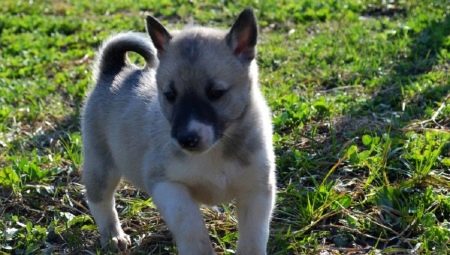
Puppies need special care and nutrition. The optimal living conditions for babies differ from those for adults. Of course, puppies of many dog breeds (for example, huskies) look like cute plush toys, but do not forget that they also need to be educated and even punished in some cases. Then, subject to all conditions, the baby will be able to become a healthy dog and a loyal friend to its owner.
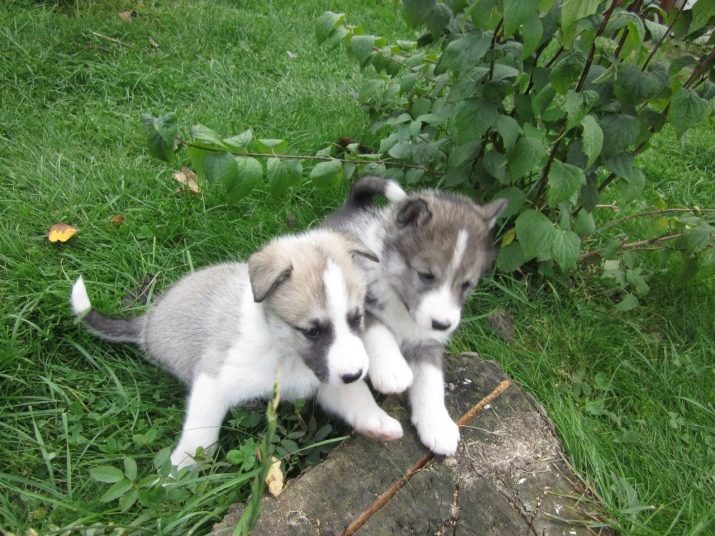
Peculiarities
West Siberian huskies have well-developed hunting instincts. This breed was bred with the aim that these dogs were able to take a trace and live in the harsh conditions of the Urals and Siberia. As a result of long-term work on crossing and selection of suitable animals, the international standard of this breed was formalized by two main groups - Khanti and Mansi dogs. Representatives of the first differ from the second in that they have a dense body, a wide head and a short muzzle. Animals from the second subgroup are more sinewy and their muzzles are somewhat longer.
According to international standards, The West Siberian Laika is a medium-sized dog with a strong body and well-developed muscles. Average her the height at the withers is about 50-60 cm, but not more than 80 centimeters. The head is in the form of an isosceles triangle with erect triangular ears. The muzzle can be long and the skull is always wide.
The eyes are oval or almond-shaped, hazel or brown. A chest with a strong muscular corset, a toned abdomen. Feet are strong and powerful. They are located almost parallel to each other. The tail is of medium length. An adult dog weighs on average 16-22 kg.
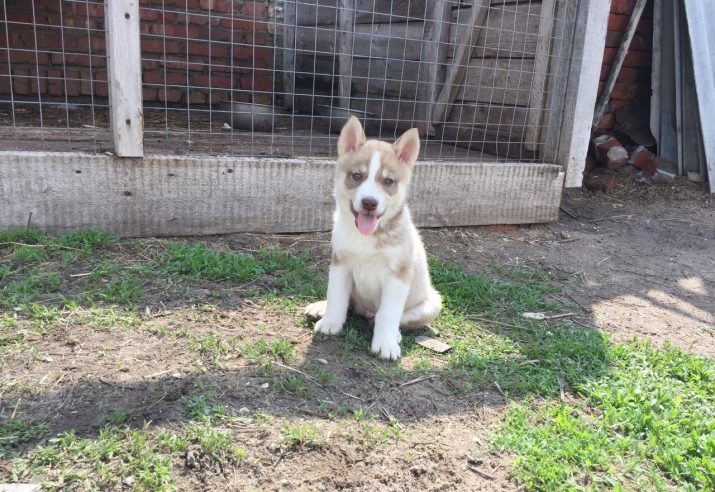
The coat is of medium length. The dense undercoat layer is well expressed.Around the neck, the cover is stronger and thicker, forming a kind of "collar". The color of the coat can be white, gray-white, gray-red, piebald, fawn, as well as black and white.
In appearance, West Siberian huskies somewhat resemble wolves, this is especially noticeable at an early age (for example, in puppies a month and younger). However, their behavior is different. By nature, these are calm, balanced animals. They are characterized by intelligence, loyalty, intelligence, fearlessness, activity. Puppies are friendly, obedient and able to easily find common language with other animals and people.
They are very energetic and playful pets. The latter features are clearly manifested as early as 1 month. Representatives of this breed lend themselves well to training.
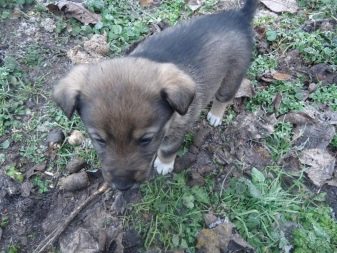
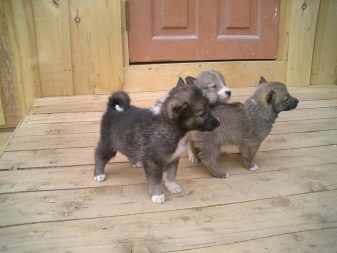
Puppies go through several stages in their development.
- The first 2 weeks from birth. At this time, the baby especially needs the mother, since it feeds only on milk and can hardly do anything. On the 10-14th day, his eyes break off. The baby is still weak for the first few days. Can define his family - mother, brothers and sisters. The kids are very cold, so if possible, the puppy should be with the mother. And dog breeders or owners must create suitable temperature conditions (22 - 25? C) for them.
- 3rd week. At 3 weeks of age, the puppy's teeth begin to erupt. Gradually, he can already be accustomed to human hands. It is also during this time that the puppy develops a sense of smell.
- From 3 weeks to 3 months. It is at this time that the baby needs to be socialized.
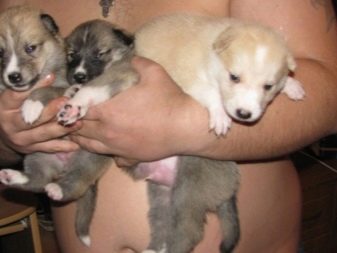
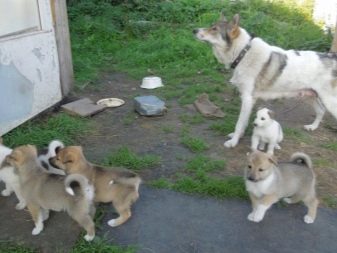
From 3 weeks until the end of the first month, the baby begins to respond to harsh stimuli (loud sound, smell, light). This means that his senses are developing properly. Kids begin to play catch-up with each other, they can chew on everything. During this period, you can train them to use the litter box, since babies stop “going to the toilet” in the same place where they sleep and eat.
At the age of two months, a husky puppy acquires the ability to express its emotional state with the help of voice and behavior. The first such manifestations begin as early as 5-6 weeks of age. At this time, he is actively exploring the world, communicating with other puppies and animals. Usually at this time, the kids are prepared for the fact that the owners will take them to their new home. At least a week before that, they are excommunicated from their mother, allowed to get used to human hands, to communicate with people.
From 8 to 12 weeks, it is important to wean the baby from biting. Usually, after two months, the puppies are handed over to buyers.
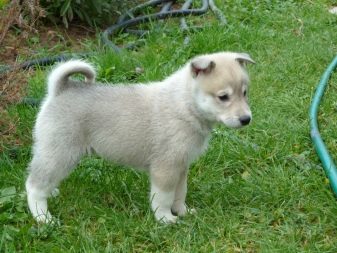
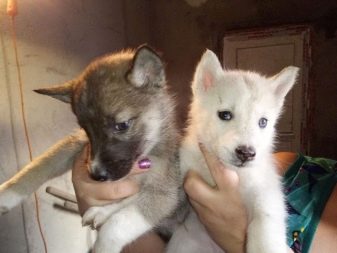
What and how to feed?
A correctly selected menu for a puppy is an important task for the owner, since his health and development will depend on what substances and products are included in the baby's diet.
The menu should be balanced and complete. Food should contain a sufficient amount of proteins, fats, carbohydrates and other useful substances - vitamins, mineral compounds. He can get proteins and amino acids necessary for intensive growth of a puppy from meat, eggs, dairy products, fish, offal and cereals. Fats enter the body from fish or fish oil. They are essential for the growth of cells and tissues.
Sources of carbohydrates are cereals. Vegetables and fruits are essential for obtaining vitamins. An important point is that there is enough fresh, clean water in the bowl.
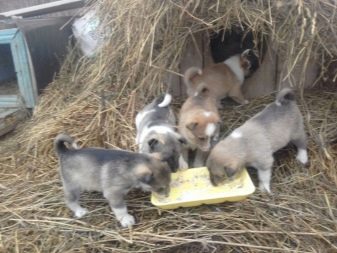
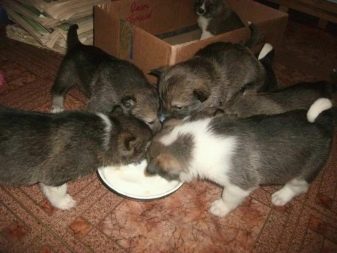
It must be remembered that you cannot feed the puppy with food from the master's table. This is because the seasonings are bad for the dog's stomach. In addition, the list of prohibited products includes:
- smoked meats;
- spices;
- spicy;
- flour and sugar;
- fatty meats (for example, pork);
- tubular bones;
- mushrooms.

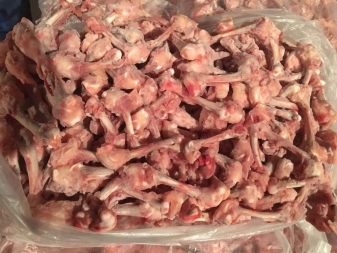

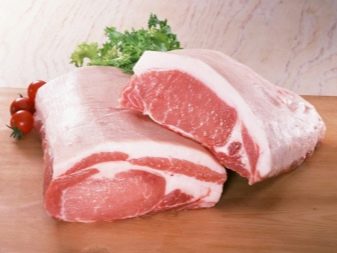
There are three feeding options for puppies. The first is that ready-made feed is used. This method is convenient for its simplicity, since most feeds contain all the necessary components in the right quantities, and are also adapted to the age needs of the animal. The second approach is to feed the puppy only natural foods.However, not everyone has enough time to cook separately several times a day for their pet. The third option is mixed. It is most often recommended by dog breeders.
The number of meals depends on the age of the baby. During the first months the puppy gains weight and grows actively. That's why he is fed quite often - every 3-3.5 hours.
Then, by 3 months, the interval between feedings is 4 hours, and the number of receptions decreases to 6. At 4 months, it is enough to feed the dog 5 times, and then until 8 months - 4 times a day, and already at 8 months of age the puppy is transferred to Three meals a day.
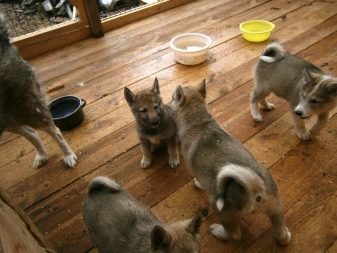
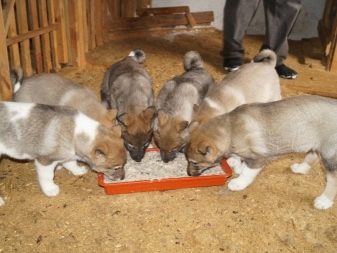
How to walk?
Spacious open-air cages or booths are better suited as housing for the West Siberian husky. Also, a puppy can live in an apartment, but he must have his own place. Walks should be long enough in time and intense in activity. The required elements are running, playing (for example, with a ball, stick). Outdoor training can also take place for teams. It is important to remember that husky needs a change of occupation - the puppy is given the opportunity to just run, walk on a leash, play. After all, this is still a child, and it is difficult for him to focus his attention on one thing.
Experienced breeders recommend walking your pet on a leash. However, it must be long enough for the puppy to be able to run.
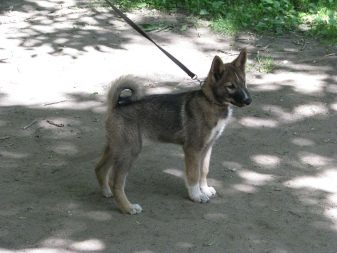
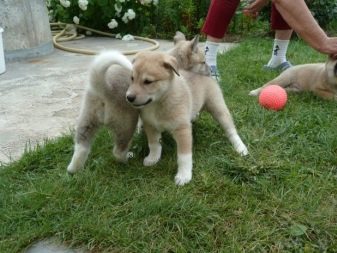
Hygiene procedures
Usually, taking care of likes does not cause any particular problems. However, there are rules and peculiarities here.
During the moulting of the dog, you should be prepared for the fact that thick hair can be in different places of the apartment. That's why you need to carefully comb out the puppy with a stiff brush... It is important to bathe him, but not often. However, if the dog's coat is white, then this procedure should be carried out as the pet becomes dirty.
At least once a year, you need to visit a doctor for a routine examination, as well as regularly vaccinate.
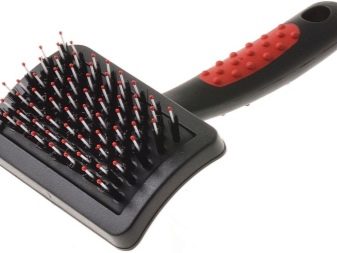

How to train?
As a rule, puppy training begins at an early age and from the first days of a new pet in the house. This helps him to get comfortable. Raising a 2-month-old baby helps to establish a bond between the owner and the pet. it includes active games, as well as the study of commands "near", "to me", "sit" and so on. An important nuance is the regularity of the classes.
To better understand how to raise your dog, breeders recommend contacting experienced dog handlers. They will tell you how to instill in your dog hunting skills, how to properly train it to take a trail and how to properly care for it. Difficult and special training should not be done until the puppy is 8 months old. Before doing this, it is important to make sure that the pet has learned the basic commands.
If something does not work out in self-training, then you can always visit the dog handler and consult him.
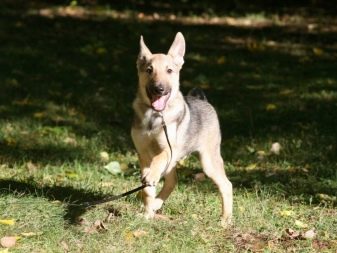
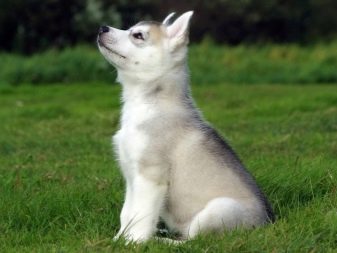
You can look at the beautiful husky puppies below.



































And my puppy does not eat dry food. The meat requires.
Gradually, imperceptibly add dry food to the meat: you just need to get used to a different smell. Tested. Good luck.